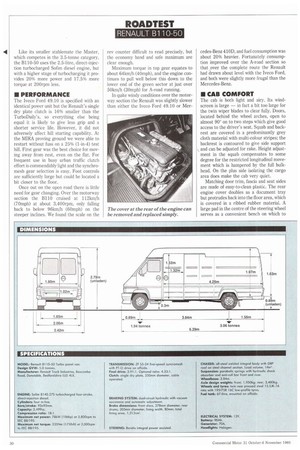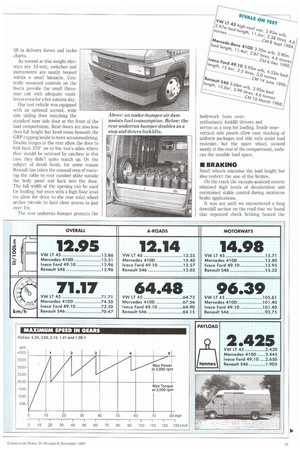ROADTEST
Page 32

Page 33

Page 34

If you've noticed an error in this article please click here to report it so we can fix it.
RENAULT B110-50
Like its smaller stablemate the Master, which competes in the 3.5-tonne category, the B110-50 uses the 2.5-litre, direct-injection turbocharged Sofim diesel engine, but with a higher stage of turbocharging it provides 20% more power and 17.5% more torque at 200rpm less.
• PERFORMANCE
The lveco Ford 49.10 is specified with an identical power unit but the Renault's single dry plate clutch is 16% smaller than the TurboDaily's, so everything else being equal it is likely to give less grip and a shorter service life. However, it did not adversely affect hill starting capability. At the MIRA proving ground we were able to restart without fuss on a 25% (1-in-4) test hill. First gear was the best choice for moving away from rest, even on the flat. For frequent use in busy urban traffic clutch effort is commendably light and the synchromesh gear selection is easy. Foot controls are sufficiently large but could be located a bit closer to the floor.
Once out on the open road there is little need for gear changing. Over the motorway section the B110 cruised at 1121unili (70mph) at about 3,400rpm, only falling back to below 96km/h (60mph) on the steeper inclines. We found the scale on the rev counter difficult to read precisely, but the economy band and safe maximum are clear enough.
Maximum torque in top gear equates to about 64km/h (40mph), and the engine continues to pull well below this down to the lower end of the green sector at just over 50kmTh (30mph) for A-road running.
In quite windy conditions over the motorway section the Renault was slightly slower than either the Iveco Ford 49.10 or Mer cedes-Benz 410D, and fuel consumption was about 20% heavier. Fortunately consumption improved over the A-road section so that over the complete route the Renault had drawn about level with the Iveco Ford, and both were slightly more frugal than the Mercedes-Benz.
• CAB COMFORT
The cab is both light and airy. Its windscreen is large — in fact a bit too large for the twin wiper blades to clear fully. Doors, located behind the wheel arches, open to almost 90° on to two steps which give good access to the driver's seat. Squab and backrest are covered in a predominantly grey cloth material with multi-colour stripes; the backrest is contoured to give side support k, and can be adjusted for rake. Height adjustment in the squab compensates to some degree for the restricted longitudinal movement which is hampered by the full bulkhead. On the plus side isolating the cargo area does make the cab very quiet.
Matching door trim, fascia and seat sides are made of easy-to-clean plastic. The rear engine cover doubles as a document tray but protrudes back into the floor area, which is covered in a ribbed rubber material. A large pad in the centre of the steering wheel serves as a convenient bench on which to fill in delivery forms and tacho charts.
As normal at this weight electrics are 12-volt; switches and instruments are neatly housed within a small binnacle. Centrally mounted controls on the fascia provide the small threeman cab with adequate ventilation even for a hot autumn day.
Our test vehicle was equipped with an optional second, wide side sliding door matching the standard near side door at the front of the load compartment. Rear doors are also less than full height but head room beneath the GRP capping inside is more accommodating. Double hinges at the rear allow the door to fold back 270' on to the van's sides where they should be retained by catches: in this case they didn't quite match up. On the subject of detail finish, for some reason Renault has taken the unusual step of routeing the cable to rear number plate outside the body panel and back into the door. The full width of the opening can be used for loading, but even with a high floor level (to allow for drive to the rear axle) wheel arches intrude to limit clear access to just over lm.
The rear underrun bumper protects the
bodywork from over enthusiastic forklift drivers and
serves as a step for loading. Inside nearvertical side panels allow easy stacking of uniform packages and side rails assist load restraint, but the spare wheel, stowed neatly at the rear of the compartment, reduces the useable load space.
• BRAKING
Small wheels minimise the load height but also restrict the size of the brakes.
On the track the vacuum-assisted system obtained high levels of deceleration and maintained stable control during maximum brake applications.
It was not until we encountered a long downhill section on the road that we found that repeated check braking heated the brakes to the point of fade. The rear brake drums are equipped with automatic wear adjustment; the front disc pads are also selfcompensating.
With anti-roll bars fitted to the front and rear axles the multi-leaf parabolic suspension provided a comfortable, if firm ride, without much roll. Power steering gives a
Motorway: average speed, 96.39km/h (59.9mph); fuel consumption, 14.981it/100km (18.85mpg). A-road: average speed, 64.48km/h (40.07moh); fuel consumption, 12.141it/100km (23.27mpg). Overall results: average speed, 71.17km/h (44.23mph); fuel consumption, 12.951it/ I 00km (21.82mpg),
positive feel and snakes light work of tight slow-speed manoeuvres.
Routine service checks are made below the short bonnet.
The dip stick is tucked away well to the rear and can be awkward to replace, but the oil filler is more accessible.
The rear cover can be removed without taking out the passenger seat to allow closer inspection of the rotary fuel pump, injectors and turbocharger. In the adaptation to righthand drive for the UK the throttle cable has been made to follow a tortuous route which may make a replacement difficult to fit, but it works smoothly enough.
Renault has entered its second player in a market which is barely large enough to retain the interest of existing competitors. In doing so it competes against Iveco Ford's 49.10 which, with the same engine and gross weight, offers more payload and larger body volume for about £500 less.
The Mercedes-Benz 410D, rated at 4.6 tonnes gross, gives about the same payload, albeit with less volume, and costs £2,000 less.
Against other contenders it scores well with its payload and volume but falls down on its price.
While overall fuel consumption is competitive, motorway consumption proved to be heavy, even taking adverse conditions into account. If Renault simply plans to replace the 50 Series then the B110-50 is up to the job. But in the meantime Renault's dream of re-establishing market leadership with the help of sales to small businesses does not seem likely to be brought to reality with this contender.
Ell by Bill Brock




















































































